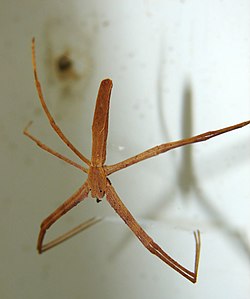Deinopis
| Deinopis | |
|---|---|
 |
|
| Deinopis subrufa | |
| Scientific classification | |
| Kingdom: | Animalia |
| Phylum: | Arthropoda |
| Class: | Arachnida |
| Order: | Araneae |
| Suborder: | Araneomorphae |
| Family: | Deinopidae |
| Genus: |
Deinopis Macleay, 1839 |
| Species | |
|
D. longipes |
|
| Diversity | |
| 46 species | |
| Synonyms | |
|
Dinopsis Macleay, 1839 – orthographic variant |
|
D. longipes
D. ravida
D. subrufa
Many others, see text.
Dinopsis Macleay, 1839 – orthographic variant
Deinopis is a genus of spiders known as net-casting spiders, gladiator spiders and ogre-faced spiders. Its distribution is widely tropical and subtropical. They catch their prey using a specially spun "net".
The genus name is derived from the Greek deinos "fearful" and opis "appearance"; see also the family name "ogre-faced" spiders.
The spelling Dinopis is also found, but this is regarded as "an unjustified emendation".
Spiders in the genus Deinopis catch their prey in an unusual fashion. They first spin a small upright rectangular cribellate web. This is then detached from its supporting threads and held horizontally above the ground by the spider's long front two pairs of legs while the spider hangs almost vertically. Passing prey is then captured by dropping the "net" over it.
The two posterior median eyes are enlarged and forward-facing, with compound lenses. These eyes have a wide field of view and are able to gather available light more efficiently than the eyes of cats and owls. This is despite the fact that they lack a reflective layer (tapetum lucidum); instead, each night a large area of light sensitive membrane is manufactured within the eyes, and since arachnid eyes do not have irises, it is rapidly destroyed again at dawn. To aid further in netting prey, the spider places white fecal spots on the surface below the net and uses them for aiming.
...
Wikipedia
